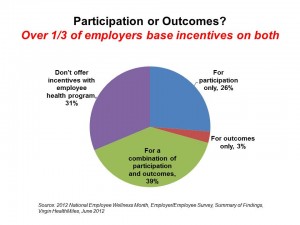One-third of employers will increase investments in wellness programs in 2013. Employers look to these programs to reduce health care costs, to create a culture of health, to improve workforce productivity, and to enhance employee engagement. Workers say wellness programs are important in their choice of employer. But while employers and employee chasm agree on that point, there’s a gap between how employers see the programs’ benefits, and how aware (or unaware) employees are.
Call this a Wellness Literacy Gap, akin to health literacy and health plan literacy. Over one-half of employers believe employees understand the programs they offer, but workers say they’re largely uninformed about these benefits. Less than one-half of employees understand how to participate in wellness programs, such as disease management, smoking cessation, stress and mental health management. This gap exists even with one-third of employers implementing both participation and outcomes to drive incentives in the program.
What people say they want are physical activity programs (78%), on-site fitness centers (74%), nutrition counseling, health risk assessments, and health club memberships (each with 69% of workers valuing that benefit).
Those employees who do partake in wellness programs note various kinds of success on the programs: 51% report weight loss and lower BMI, 49% say they’ve got more energy, and 57% say they feel healthier and happier.
Employers point to several key obstacles in implementing wellness programs: primary among these are budget, concerns about programs’ ability to change employee behaviors, and lack of ability to measure the programs’ impact and outcomes.
The 2012 National Employee Wellness Month survey was conducted on behalf of Virgin HealthMiles by Workforce Management magazine among 772 U.S. employers in April-May 2012.
Health Populi’s Hot Points: Employers are missing an opportunity to close the Wellness Literacy Gap by not employing the tools of social media to promote wellness programs and inspire workers who participate to sustain healthy behavior change. Only 9% of organizations polled in this survey say they use social media to promote the programs. Instead, the vast majority of companies use traditional communications media including emails, the company intranet, on-site posters, newsletters, and that great old stand-by, health fairs on-site.
As one participant employee in a wellness program said in a verbatim statement on the survey, “It’s always great to have a buddy or more to help you all keep each other accountable.” With 77% of employers concerned about their ability to change employee behaviors, greater and engaging use of social media could help mitigate that challenge.





 Thank you FeedSpot for
Thank you FeedSpot for